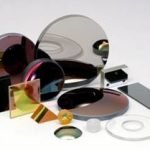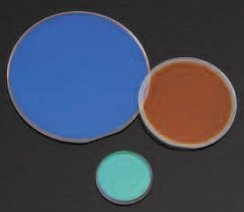
Optic Lens Manufacturer
Friday, 23 December, 2016
Precision Optical Coatings
Friday, 23 December, 2016Most optical filters are plane-parallel items like precision optical windows, except that they select exactly which portion of light to transmit. The remaining light may be reflected, absorbed, or both. Types of filters include neutral density (ND), linear polarizer, short-pass, long-pass, hot or cold, band-pass, line-transmission, and notch filters.
Neutraldensity filters absorb and attenuate all colors of light equally; they have a grey or black appearance. They are specified by an “optical density” (OD), which is the number of powers of ten by which they attenuate light: An OD of 1 lets 10% through while an OD of 6 lets through one part in a million
ND filters can be stacked; their resulting combined density is the sum of their densities. ND filters are usually made of an absorbing filter glass and polished to the exact thickness required to achieve the specified OD. Thin metallic coatings can be used in combination with the filter glass. Fractional OD’s are possible.
Linear polarizers pass only one orientation of polarization. Depending on type, they may reflect or absorb the rest. There are many ways to construct linear polarizers, including micro-patterned glass, glass with preferentially aligned internal micro-crystals, plastic polarizing films cemented between glass plates, or a dielectric coating on the surface of the glass. This last type must be installed at a particular angle, but it has the lowest absorption and highest power handling ability.
Short- and long-pass filters may consist of a substrate made of either clear glass or a specially compounded colored filter glass, with a dielectric surface coating to optimize its performance. The short pass as you may guess passes wavelengths shorter than a given value; likewise the long-pass passes longer wavelengths. Band-pass filters cut off wavelengths shorter and longer than the desired band.The abruptness of the transition, the degree of transmission and attenuation, are all important design decisions.
Hot mirrors and cold mirrors are a subset of short- and long-pass filters. A cold mirror reflects visible light from a thermal light source toward the system, while transmitting near infrared (IR) ranging from about 750 to 1250 nm to be dumped so that the rest of the system isn’t adversely affected by the heat energy. A hot mirror reflects the IR; the transmitted light goes to the rest of the system. With a hot mirror, the reflected IR can be directed back at the filament or arc to increase the illuminator’s efficiency.
Line filters are made for either laser lines or chemical spectrum lines. As examples, astronomers often use a hydrogen-alpha (H-a) filter which pass only the light from excited hydrogen at 656.28 nm, and laser-guided missiles have filters that allow them to see only the laser spot on the target.
Notch filters allow you to completely reject a laser line so that it doesn’t blind the camera in your surgical instrument (or the surgeon), while not affecting the color appearance of the surrounding tissue. Notch filters are usually specified with a bandwidth and an OD. Multiple notches are possible in the same filter.
Tower Optical has the expertise to guide you through the options, and the manufacturing capabilities to deliver what you need. Contact us to speak with one of our sales engineers.



